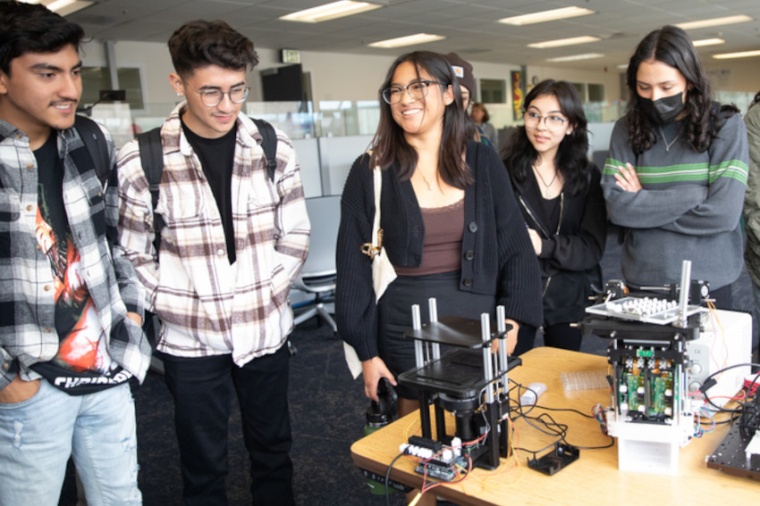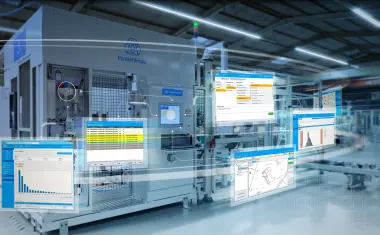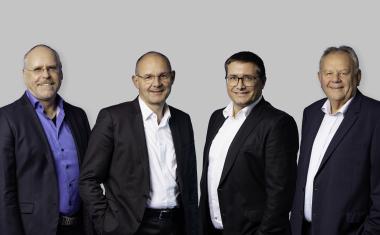Microscopy on remote
Cloud-controlled microscope brings complex biology education to students worldwide.
In many communities around the world, students’ ability and enthusiasm to pursue STEM fields in their high school and college careers is limited by a lack of resources which prevent them from accessing complex, project-based curriculum like their peers. The Covid-19 pandemic has exacerbated these existing educational inequalities, requiring new solutions to democratize access to this field. UC Santa Cruz researchers have developed a method for using remote-controlled, internet-connected microscopes to enable students anywhere in the world to participate in designing and carrying out biology experiments. A new study details this novel and scalable framework for bringing project-based STEM education to students who otherwise would not have access.

The researchers implemented the microscope technology in the biology classrooms of several Latinx communities in the United States and Latin America, and found their technology to be an effective and scalable approach for giving students underrepresented in STEM the ability to conduct complex experiments remotely. “Taking an internet-connected camera and putting it into the viewpiece of a microscope is something that a lot of labs could do,” said Pierre Baudin, a computer engineering Ph.D. student at the Baskin School of Engineering. “By laying out the framework in this paper, the idea was to create a roadmap so any lab that feels some kind of mission or desire to create educational resources for their community or others may be able to set up a similar kind of experiment, allowing this concept to spread.”
Tissue culture experiments are typically unheard of in high school and even the first few years of college, and yet in user studies run for this research, underserved highschool students at Alisal High School in the rural Salinas Valley near Santa Cruz were able to do these experiments. “We are allowing students to do experiments that are normally not feasible for [many] schools around the world, either because the materials are hazardous or because the equipment is expensive or requires specific training for both the teachers and the students,” said Mohammed Mostajo-Radji, the senior researcher on this study.
While project-based learning has proven to be an effective method for teaching STEM concepts, it is restricted by barriers such as cost and logistics of shipping materials to isolated communities, limited teacher training, under-resourced schools, and potential exposure to hazardous materials. Through deep experience working with education non-profits, UCSC Genomics Institute’s Mostajo-Radji determined that a successful solution needs to be scalable and affordable, adaptable to a school’s local context, and allow students to fully explore the scientific method. Mostajo-Radji and many other researchers at the UCSC Genomics Institute involved in this project believe running complex biology experiments via remote-controlled microscopes can be a solution that fits these criteria.
The technology that powers these remote experiments was originally developed to enable researchers from multiple geographically-separate institutions to collaborate on stem-cell research as part of a multi-institution group called the Braingeneers. Graduate students Baudin and Victoria Ly developed the tool to control microscopes remotely from anywhere in the world, to enable non-invasive observation of cell cultures in incubators. Mostajo-Radji, who was formerly the Bolivian Ambassador for Science, Technology and Innovation, recognized that the microscopy technology could be leveraged for remote education amid growing equity educational gaps during the pandemic.
“[The remote-controlled microscopes] were not developed for the purpose of education,” Mostajo-Radji said. “What we did was take a lot of lessons that we learned from mine and others’ nonprofit work to build something that is pretty remarkable.” Mostajo-Radji believes this is the first method that is both truly remote and fully using the scientific method, bringing inquiry and active learning into lessons, which can be especially important for students who are less memorization-based learners. The researchers outline a framework for other labs and classrooms to run remote-controlled experiments, in which students design an experiment, make observations, analyze data, and present their findings. They learned from several user studies which employed this method locally with Advanced Placement Biology students at Alisal High School in Salinas, and abroad with students from two different universities in Bolivia and multinational students involved with the nonprofit organization Science Clubs International. The experiments were conducted in Santa Cruz and San Francisco and accessed completely remotely by the students. Each group’s lessons reflected the student’s local context and augmented an already existing curriculum.
The first pilot of the program began in Fall 2020 at the height of the pandemic. Programs varied among the different groups, typically running about eight weeks. The researchers met weekly for lessons with some of the groups of students, and with other groups they gave a tutorial on how to use the technology at the beginning and allowed them to run the experiments independently. One experiment that was run with students in Salinas was a “clinical trial in a dish” which allowed students to see the effect of novel drugs on neuroblastoma, a cancerous tumor, in cell lines. In other experiments, students studied the biocompatibility of custom-made gold and graphene nanoparticles.
Surveys run at the end of the user-study programs showed that this method positively impacted STEM identity among both cohorts, although more strongly among Bolivian students, and led to an overall increased interest in STEM for participating students. These results offered an opportunity to understand STEM motivation among Latinx populations without the extrapolation of conclusions from one, geographically-limited study. “For a lot of these education strategies and policies, [researchers] like to think that a study done in a particular region of the world is representative to inform policy in a different part of the world,” Mostajo-Radji said. “Here, for the first time, we are thoroughly comparing groups of Hispanics [in California] and Hispanics abroad, in the context of the exact same class, exact same lesson, and exact same experiments.”
The team is now in the process of applying for grants to build the infrastructure to expand this work. They envision an app that would allow high school and community college students from anywhere in the world who might not otherwise go into research to design and execute experiments completely remotely. The researchers recently created the Live Cell Biotechnology Discovery Lab to scale up the use of their technology. Ideally, they would have hundreds of microscopes running different experiments. Mostajo-Radji imagines that students from different parts of the world could be in the same group and learn from the same data together.
The researchers are actively looking for more partners through conferences to create relationships beyond the schools they worked with for this study. To this end, Mostajo-Radji recently was invited to join the U.S. National Academy of Sciences at the International Frontiers Symposium in Nairobi, Kenya to share this idea and create educational partnerships to bring these technologies to more students. The researchers are also interested in moving beyond microscopy. Areas of interest include devices to teach programming through microfluidics, and techniques for teaching electrophysiology, the study of the electrical properties of biological cells and tissues, to non-visual learners. “Microscopy, in a way, was a low-hanging fruit,” Mostajo-Radji said. “It’s just the beginning.” (Source: UCSC)
Link: Cloud Bases Technologies, Genomics Institute, University of California Santa Cruz, Santa Cruz, USA











